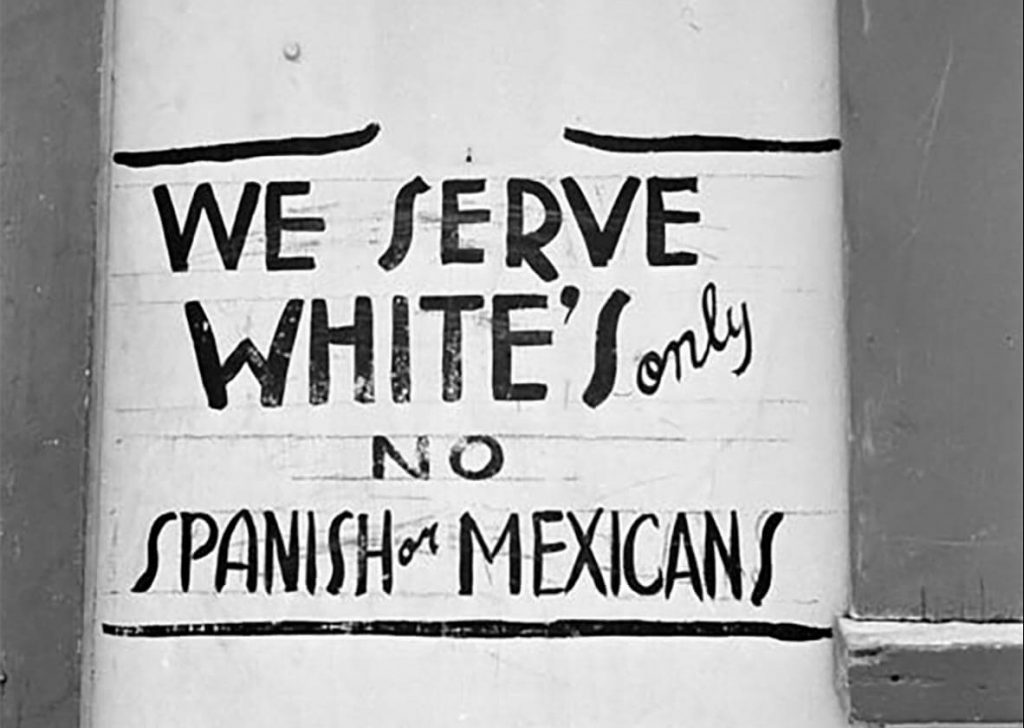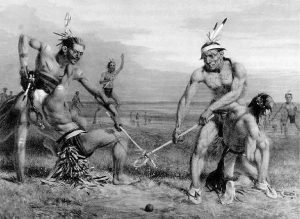1911, Antonio Gomez, a fourteen-year-old Mexican-American boy, was walking home carving pieces of wooden shingles, when suddenly a saloon owner shoved him to the street. Gomez was scolded by the saloon owner for littering on the sidewalk shouting, “the sidewalk is no wastebasket.” A group of men that was at the saloon cheered on the owner and cursed at Gomez. As the boy gathered his shingles and tried to leave, a man by the name of Charles Zieschang snatched the wooden shingles from the boy’s hand and told the owner he could, “make the damn little skunk quit whittling.” Zieschang whipped Antonio Gomez with his own wooden shingles while other men watched and ridiculed the boy. Out of self-defense Antonio Gomez stabbed Zieschang with the pocket knife he was using to carve the wooden shingles. Zieschang died from blood loss in twenty minutes.1

Mexican-Americans were somewhat immune to the racist Jim Crow policies of the south that made discrimination against black Americans legal. This was due to the fact that Mexicans were “white by law” since the signing of the Treaty of Guadalupe Hidalgo in 1848. So, the Juan Crow laws emerged as a way to legally discriminate against Mexican Americans. Through Juan Crow prejudices, Texas passed English-only laws that led to future segregation of Mexican-Americans in school systems. Anglos pushed for segregation of Mexican-Americans in school because they believed having their children learn alongside Mexican-American children would hinder them. Segregationists also believed that it was safer for their white children because they believed Mexican-Americans reached puberty earlier. Unsurprisingly the anti-Mexican efforts were blind-sided by authorities across the state giving more power to Juan crow laws that essentially justified discrimination and mistreatment of Mexican-Americans.2

Antonio Gomez was taken into custody almost immediately by constable McCoy and taken into the town jail of Thorndale, Texas. Soon after his arrest, another version of the altercation went around. Some were claiming that Gomez was the attacker who waited for Zieschang to come out of the saloon after having snatched his wooden shingle and peacefully retreating to the saloon. The people were so eager to bring their own “justice” that they were willing to act as witnesses without having seen anything. Although history has yet to prove which story is the most accurate, the only part that remains constant is the events that led up to his death. Gomez became an instant target for lynching because the citizens knew he was too young for capital punishment in the state of Texas, but they were willing to take matters into their own hands. It was reported that a mob of more than a hundred people waited for justice outside the jail. Constable McCoy who placed Gomez in jail tried to transfer him to another jail out of fear that the boy would be lynched by the people. The constable knew that the small jail could keep Antonio Gomez in, but he wasn’t sure that it could keep an angry mob out. Gomez was led through the back of the jail with a chain around his neck and straight to a house. McCoy went to look for reliable transportation to another jail while Gomez was kept in a safe place, or so he thought. Somehow the angry mob learned the location of Antonio Gomez and managed to steal him from authorities.3
Racism had grown its roots very deep and brutally here in the state of Texas. Racism in Texas stems back not only to slavery and the prejudice towards black people, but to native Americans as well. Mexicans were sometimes saved by the law which would recognize a Mexican person as “white” as long as their skin permitted it. If you were not of fair skin, then you risked being persecuted. Most Anglo-Americans had an “us versus them” mentality when it came to Mexican-Americans. This was because many Anglo-Americans picked up on American nationalism and nativism going against Mexican-Americans who were wrongly stereotyped. Mexican-Americans were usually seen as inferior, violent, and even anti-American. Racism against Mexican-Americans was like a double-edged sword. Mexican-Americans had to deal with Anglo-Americans who did not accept them and did not think they were American enough. Simultaneously, Mexican-Americans dealt with Mexicans who also thought less of Mexican-Americans, often times looking at them as traitors. Racism in the state of Texas was not only on the mere surface, but it had also been implemented systematically, from the school systems to the housing system and even the labor systems. This is because our country’s story is based on a consensus history, which means that our history is based on points of view that seeks to paint an exciting picture of our history, and downplaying the tragedies that occurred.4

Antonio Gomez was captured by an angry mob and was dragged by a horseman who managed to grab the chain that was around Gomez’s neck. Antonio Gomez’s body was found lifeless hanging from a telegraph pole next to a ladder. Only three hours had passed since the death of the man that Gomez was charged for “murdering.” The body of the child was found bruised up and beaten horribly with a chain around his neck. After beating the boy and dragging him, the men mercilessly suspended his body from the pole. Before the men managed to hang his body, they had a failed attempt where they dropped his body and kicked his head. The constable was too late when he arrived at the scene.5
How common were these anti-Mexican lynching’s? Although hateful crimes against Mexicans were common, it was not so common to be recorded for history. There are records to show that from 1848 to 1928 at least 597 deaths of Mexicans in Texas were due to mob violence or lynchings. These attacks directed towards Mexicans and Mexican-Americans were not only done by other citizens, but they were also planned systematically by Texas Rangers. Another example of brutal deaths by mob violence is the lynching and burning of Antonio Rodriguez. These acts of terror were very common in Texas, especially towards ethnic groups such as African Americans, Mexicans, and even native Americans even earlier.6

It is important to know the stories of such victims of racism and mob violence like that of Antonio Gomez or even of Jesse Washington. Although these stories are not the most appealing, it is important to recognize these people and their stories because it is our history whether we like it or not. It is important for all people to know the truth. Stories like these are even relevant today. We could look at recent laws such as SB4 that encouraged racism among law enforcement, or even the stereotypes that current president Trump has promoted. The story of Antonio Gomez shows just how far and systematic racism has been in our state of Texas or even in our country. It is important to know the entire truth of history, not just one point of view. Why haven’t you heard of Antonio Gomez? Why was Mexican-American studies just recently added to the Texas public school curriculum in 2014, and only as an elective? Why isn’t the history of Mexican people in our textbooks when it is a vital part of who we are and where we come from, especially here in Texas?
- Nicholas Villanueva,The Lynching of Mexicans in the Texas Borderlands (Albuquerque: University of New Mexico Press, 2017), 125; George T. Diaz, “A Review of the Lynching of Mexicans in the Texas Borderlands,” Southern Spaces, no. 1 (2018): https://southernspaces.org/2018/review-lynching-mexicans-texas-borderlands/ . ↵
- George T. Diaz, “A Review of the Lynching of Mexicans in the Texas Borderlands,” Southern Spaces, no. 1 (2018): https://southernspaces.org/2018/review-lynching-mexicans-texas-borderlands/. ↵
- Nicholas Villanueva,The Lynching of Mexicans in the Texas Borderlands (Albuquerque: University of New Mexico Press, 2017), 125. ↵
- Marlon Bishop and Julia Shu, “The History of Anti-Mexican Violence and Lynching” Latino USA, no. 1(2016): 1-2, https://www.latinousa.org/2016/03/11/the-history-of-anti-mexican-violence-and-lynching/; William D. Carrigan, Forgotten Dead: Mob Violence Against Mexicans in the United States (Oxford: Oxford University Press, 2013), 77. ↵
- Nicholas Villanueva,The Lynching of Mexicans in the Texas Borderlands (Albuquerque: University of New Mexico Press, 2017), 125, http://search.ebscohost.com/login.aspx?direct=true&db=nlebk&AN=1423320&site=eds-live&scope=site; George T. Diaz, “A Review of the Lynching of Mexicans in the Texas Borderlands,” Southern Spaces, no. 1 (2018): https://southernspaces.org/2018/review-lynching-mexicans-texas-borderlands/ . ↵
- William D. Carrigan, Forgotten Dead: Mob Violence Against Mexicans in the United States (Oxford: Oxford University Press, 2013), 77. ↵




58 comments
Ana Barrientos
I am in total shock, I have never heard of the Juan Crow laws. It’s insane to me that Mexican-American history is BARELY being taught. Why didn’t we learn about it earlier? Why has this been hidden for so long? I truly have so many questions. Antonio’s story was absolutely heartbreaking, he was punished because he defended himself? People were acting like witnesses when they weren’t even there? My heart breaks for him. I just want to say thank you for writing this article, even though this article was extremely saddening and gut-wrenching I would have never known about Antonio’s story and I would have never known about Juan Crow laws.
Phylisha Liscano
A very heart breaking article and you did an excellent job telling it and included so much more details and facts. I had never heard of any of this. Reading about the brutality that was done to Antonio Gomez was awful. Knowing he was just a young boy is very sad. He was minding his business Until those men decided to cause a scene. Great article!
Claire Saldana
As soon as I began this article I automatically thought to myself why have I never heard of this story. The more I have studied Anti-Mexican American efforts the more I wonder why I was not taught this in primary school. Why did I have to wait till college for this to be an important piece of history to my culture and to my home state? This could be my fault and of course the education board for not including it in the curriculum but also my parents. This was a child who lost his life simply because of the color of his skin. These men who truly murdered this boy did this for “justice” as the author points out. I think the culture of “downplaying history” needs to be brought to the front of the table for discussion. I look forward to using this article as another example of why the curriculum especially in Texas must be revised until it is representative of history in its entirety.
Lauren Castaneda
Reading this article was very interesting and eye opening as well. I personally had never heard of the Juan Crow laws until reading this article. In school we’re always taught about the harsh realities that African Americans and Mexican Americans went through but to a certain extent. I found that the story of Antonio Gomez was similar to that of Emmitt Till, a young boy who was lynched on the basis of a false accusation made. Both are similar as they were shockingly vile to hear. Overall, I believe being taught about individuals such as Emmitt Till and Antonio Gomez is necessary for the public to be aware of because it is what shaped our nation and its growth.
Edward Cerna
This was truly a great article even though it was so heartbreaking. I have never heard of any of these events or Jaun Crow laws. It seems like these events are not taught to us which is unfortunate. I like how the article was laid out and organized because it made the article easy to read and easy to absorb the information. Overall, this is a very great story that kept me engaged throughout the article.
Monserrat Garcia
I am at a loss for words. I had never heard of Antonio’s story and being of Mexican descent it worries me of all the other stories I have not heard. It is devastating that the public school system has just added Mexican-American History as an elective to our curriculum, even then I do not think they offered that course in my high school. This article is so important to share in our community and I thank you for writing about the truth.
Soleil Armijo
This story is heartbreaking. I was completely unaware of that instances like this even existed nor did I know Juan Crow laws existed either. It’s infuriating, truly. Especially that this story is about a little boy who probably didn’t know any better and reacting with fear for his life. I appreciated your break up of the story with parts of information and then the story again, it was clever and engaging. It made the story hit harder, and all that more heartbreaking.
Linae Totten
Paul,
Antonio’s story is heartbreaking. You’re right, I never heard of this little boy or Juan Crow laws until now. Antonio was only a child and was brutalized for protecting himself. The laws that prevented Mexican American children from attending the same schools as white children were absurd and not too far off from the stereotypes placed of black people. They really made up anything just so long as they remained separate and supreme. It’s unfortunate that this side, the uglier side, isn’t told in addition to other Texas history. I agree that the racism here in America period has strong roots. It’s hard for anyone to deny it when they read about tragedies like these.
Sehar Sohail
I would say that this article is really an eye opener for many readers. Before reading this article, I had no clue that Mexican Americans have to go through and face discrimination problems. In history classes nobody really focuses on this issue, in history we are mainly taught discriminations against other races. The article mentions a very important point and I agree that if we are learning history we should learn about both accomplishments and the mistakes that are made too.
Celeste Loera
The last paragraph hit me hard, racism and the truth of america is always sugar coated and not talked about enough in schools. I didn’t even know about the Juan crow laws and it is infuriating. I remember in history class wondering how Mexican Americans were discriminated against and it was just never apart of the curricular. I really wish these kind of things were taught so everyone can be able to educate themselves on these things.